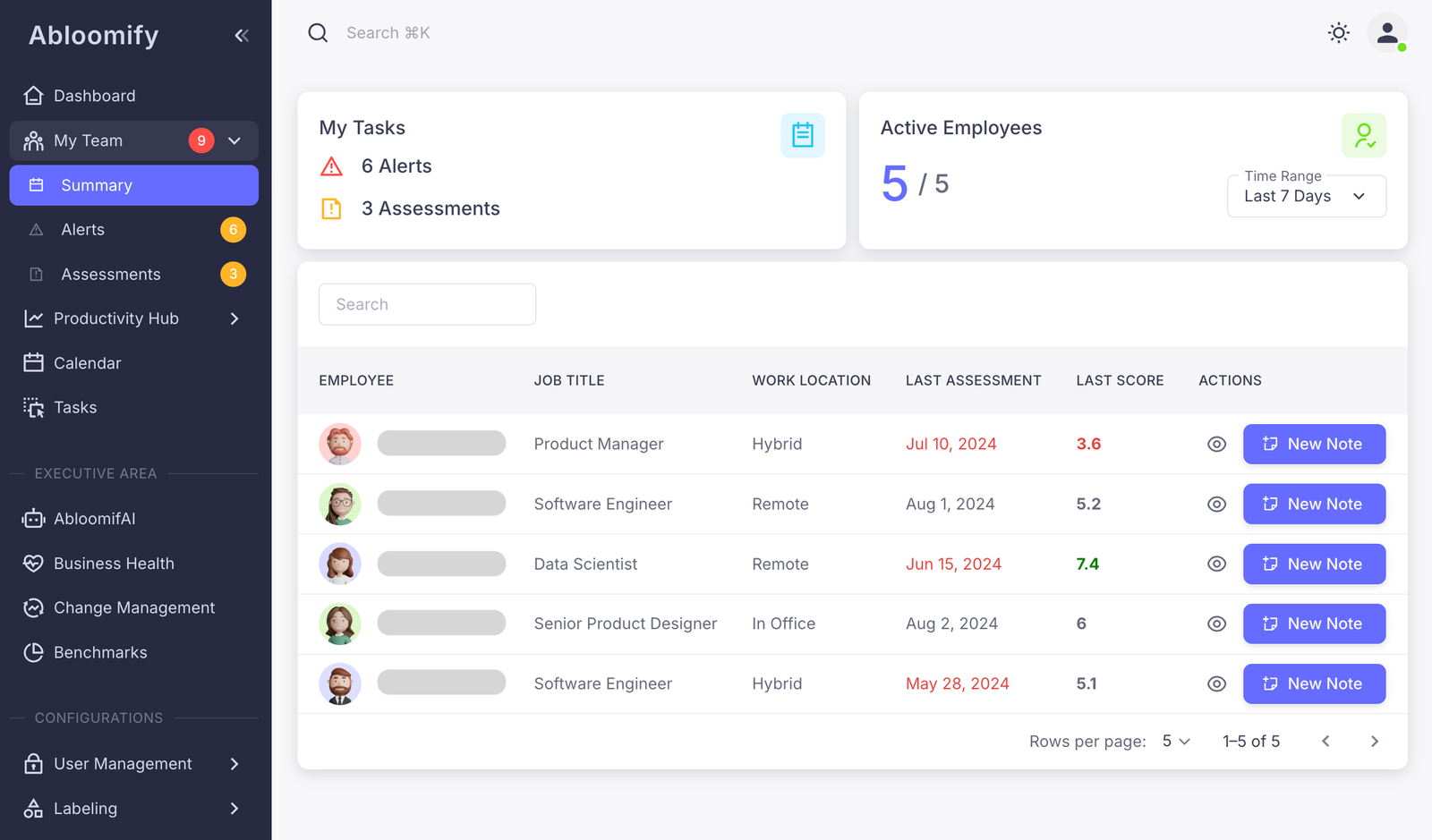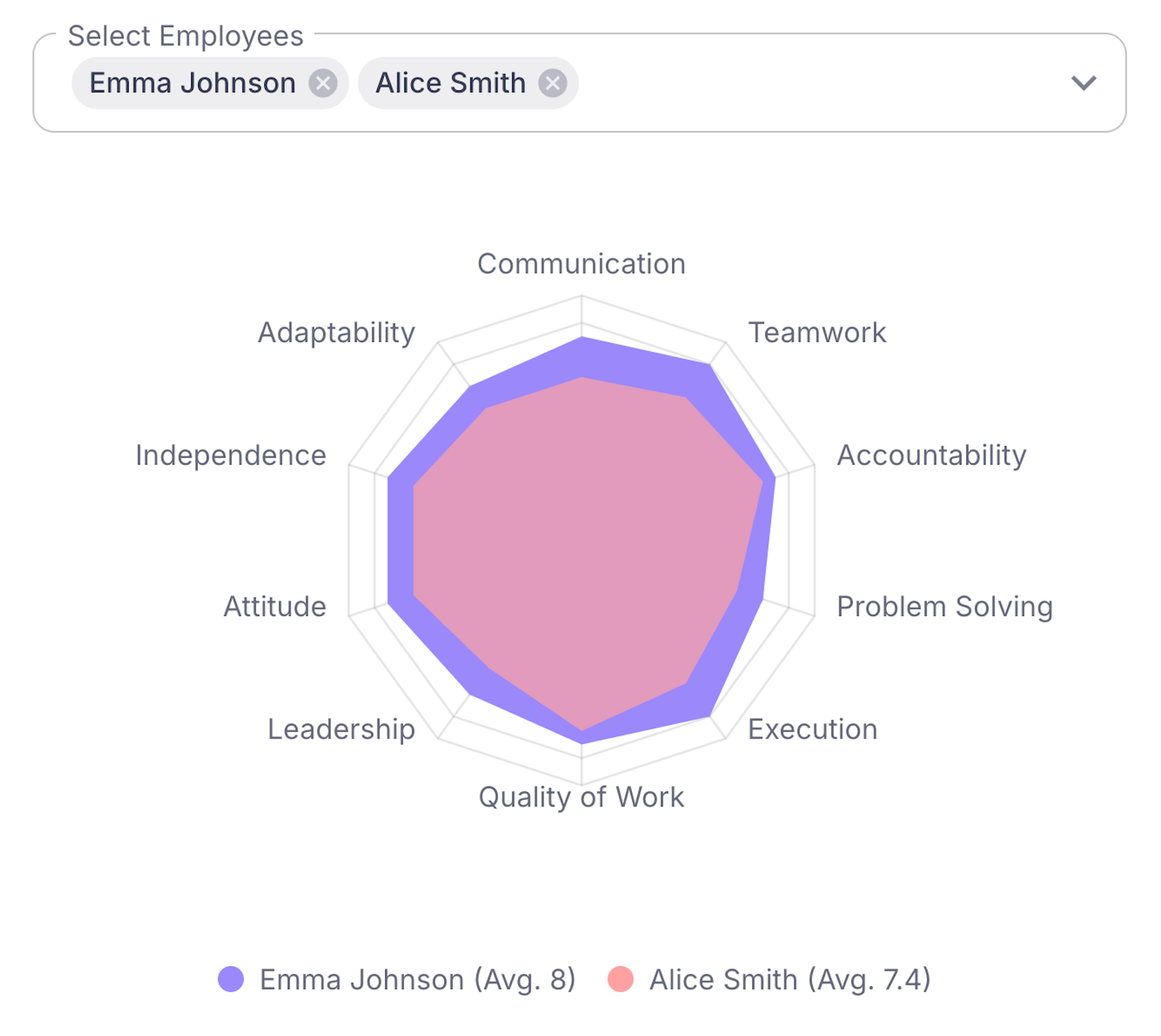Embracing innovative feedback technologies is crucial for tech companies aiming to foster agile and resilient teams. The journey toward leveraging AI-powered tools can position organizations to navigate challenges, enhancing team productivity and engagement.
The Importance of Employee Feedback in Tech
Employee feedback isn’t a tool, it’s the foundation of thriving tech firms. Feedback acts as a compass, guiding developers and engineers toward realizing their highest potential. In tech companies, it’s not just about annual reviews. It’s about creating a loop of continuous feedback that fuels innovation and personal growth.
Consider the unique challenges tech teams face. Rapid innovation cycles demand agility. When feedback is immediate and actionable, it allows teams to pivot quickly. Timely insights can reveal emerging issues like disengagement and burnout before they impact project timelines and employee morale.
Tech teams, like finely-tuned machines, need regular checks. Employees thrive on clarity. Here’s what happens in a feedback-rich culture:
- Employees feel valued and understood, boosting engagement and satisfaction.
- Managers can recognize contributions and address areas for improvement promptly.
- Teams can align better with organizational goals, driving collective success.
Furthermore, feedback can be the lifeline for those silently struggling. It’s not always about steering but about offering a lifeline to employees moving toward burnout. As leaders, we should embrace open communication channels where feedback can flow freely.
By fostering a feedback-rich culture, tech companies harness ideas and innovations from every corner. It becomes a strategic edge. Adopting systems that enable this, such as modern performance management strategies, ensures teams remain resilient and motivated. Incorporating workforce analytics, like those discussed in Unlocking the Power of Workforce Analytics, can provide deeper insights into team dynamics. Feedback is the bridge that connects individual growth to organizational success, cultivating an environment where everyone can contribute their best.
Emerging Trends in Feedback Technology
- Actionable Insights: AI doesn’t merely collect data. It transforms raw numbers into meaningful actions. Think of patterns that might indicate a budding problem or highlight a hidden strength.
- Trend Prediction: By analyzing historical data, AI can predict future trends. This foresight is invaluable. It allows companies to pre-emptively address issues before they escalate.
- Personalized Feedback: Each employee is unique, and so should be the feedback they receive. AI allows feedback to be curated to individual needs, enhancing personal growth and satisfaction.
AI-Powered Insights: A Game Changer
As leaders, we’re always scouting for ways to amplify our team’s potential. AI-powered insights are one such game changer. Imagine a tool like Abloomify’s, giving real-time analytics and alerts. It’s akin to having a compass that not only points north but alerts you to upcoming storms.
AI doesn’t just gather data; it translates it into actionable insights:
- Immediate detection of burnout: AI tools analyze data patterns to preemptively identify signs of employee exhaustion.
- Boosting productivity: By recognizing trends, AI suggests tailored solutions to enhance team performance.
- Continuous performance evaluation: Unlike static annual reviews, AI continually assesses and provides up-to-date feedback.
This fosters a culture centered on constant improvement, where employees feel supported and understood.
Moreover, AI doesn’t just shine light where we expect it. Its predictive capabilities allow leaders to anticipate future needs and make strategic decisions accordingly. It’s about learning the rhythm of your workforce and dancing in tune. Insights from platforms like Abloomify guide decisions that resonate with both the organization’s goals and its people.
In this digital age, embracing AI is not just about adopting a tool; it’s about shifting our mindset. It’s understanding that AI can humanize data, turning abstract figures into tangible actions. For those ready to adapt, this isn’t just a technological progression; it’s a leadership evolution.
Explore more about how AI-driven insights can transform workplace performance with AI strategies for workforce optimization.
Key Tools and Features in Feedback Technology
The power of effective feedback technology lies in its tools and features that directly enhance employee engagement and productivity. Consider Abloomify, a platform that embodies essential aspects like 360° feedback, performance tracking, and automated meeting tools.
With 360° feedback, employees receive comprehensive insights from peers, managers, and self-assessments, creating an environment ripe for continuous personal growth. Meanwhile, performance tracking goes beyond sheer evaluation. Real-time data aids in recognizing patterns, driving customized growth paths that spur engagement.
Automated meeting tools take collaborative productivity to another dimension. They keep teams connected, ensure meetings are structured, and promote efficient knowledge sharing. Abloomify’s AI Manager Copilot is a game-changer. It provides support for hybrid teams through workforce planning tools that are adaptable and insightful, ensuring teams remain balanced and focused.
User-friendly design is indispensable. Tech lends no value if it overwhelms users with complexity. A seamless interface integrated with existing workflows means less friction and more adoption. Tools like Abloomify, which merge effortlessly into daily tasks, foster a culture where feedback doesn’t interrupt but enhances work.
For leaders, the secret lies in recognizing that these tools aren’t just for performance evaluation. They nurture the nuances of human engagement. By understanding how to leverage such innovations, organizations can set a course toward an empowered workforce and thriving company culture.
Implementing Feedback Technology in Your Organization
Choosing the right feedback technology tool can transform tech teams. Begin by assessing your organization’s needs. Identify what you aim to achieve with feedback technology. Are you seeking improved team performance, better engagement, or clearer communication? Pinpoint these goals first.
Next, research and trial various platforms. Evaluate each tool’s features against your goals. Consider 360° feedback capabilities, performance tracking, and automated functionalities. Platforms like Abloomify offer tools that seamlessly integrate with existing tech systems.
Ensure alignment with company processes. Feedback technology should not disrupt; it should enhance. Check compatibility with current tools and platforms. An adaptable and user-friendly design is crucial. This reduces resistance and accelerates adoption.
Preparation is key. Begin with a pilot program involving a small team. This test phase highlights any issues. Gather feedback from users and make necessary adjustments. Regular check-ins ensure alignment with objectives and set the stage for organization-wide rollout.
Once ready, focus on training. This is essential for successful implementation. Ensure that all members understand the features and benefits of the new technology. Engage leaders as champions of the tool. Their support drives wider acceptance.
Finally, create a feedback loop within the system. Encourage ongoing input to refine the tools and processes. Visit this resource for insights on creating effective feedback systems.
Integrating feedback technology involves careful selection, methodical implementation, and continuous refinement. Embrace the journey to unlock potential within your tech teams.
Measuring Success and Adapting to Change
Success in leveraging feedback technology hinges on metrics that quantify performance enhancements. Organizations need to look beyond superficial improvements and delve into data with precision.
Some vital indicators include:
- Employee Engagement: Increased engagement often signals effective use of feedback. Tools that harness AI to analyze sentiment can provide insights beyond human perception.
- Productivity Metrics: Seamless workflows and decreased bottlenecks often correlate with diligent feedback processes.
- Adaptability: How swiftly and effectively teams adapt to change based on feedback highlights the technology’s impact.
Crucially, measuring success is not static. Organizations must embrace continuous evaluation. Using dynamic dashboards can visualize trends in real time. If performance metrics plateau, it’s time to question and pivot. Implementation must feel evolutionary, not revolutionary.
Consider a tech firm that integrated feedback technology to streamline development cycles. By analyzing developer feedback, they identified adoption barriers in new tools. Subsequent training sessions tailored to this feedback cut cycle times by 30%. As a result, projects rolled out faster and revenue surged.
Actionable insights are the backbone of enduring growth. Feedback technology isn’t just about gathering data—it’s about leveraging it for change. By nurturing a culture that values feedback, organizations can ensure ongoing development and relevance.
Read more about how workplace workforce analytics support this transformation by providing crucial insights that drive performance. This holistic approach guarantees sustainability and positions organizations to not just survive, but thrive.
The Future of Feedback in Tech
Imagine a future where feedback isn’t just a tool, but a transformation. As tech companies evolve, so too will the platforms that capture and analyze employee sentiment. The edge? Intuitive AI systems that do more than process data: they predict needs, flag risks, and unlock insights with unprecedented precision.
Here’s a vision of what’s on the horizon:
- Predictive Analytics: No longer just reactive, future feedback tools will anticipate challenges before they manifest. Leveraging past data, these AI solutions will provide preemptive strategies to tackle potential setbacks in team dynamics or project timelines.
- Real-time Feedback Loops: With advancements in AI and data integration, instant feedback will become the norm. Employees could receive guidance in the moment, fostering an environment of continuous growth and adaptation.
- Sentiment Analysis: Beyond surface-level comments, AI-driven sentiment analysis will delve deeper into emotional undertones. Understanding the true sentiment behind feedback can empower leaders to tailor their management strategies, enhancing employee satisfaction.
- AI-driven Personalization: Feedback technology will evolve to offer personal growth plans, utilizing individual performance insights to suggest specific learning resources or suggest career development paths.
Embracing these changes means staying informed and agile. Be ready to invest time in learning and adapting as new trends emerge. For more insights into enhancing team performance in tech, explore tips for increasing employee engagement, and position your organization to not just keep up, but lead in the evolving landscape.
Final words
Harnessing employee feedback technology is imperative for tech leaders seeking sustainable success. Tools like Abloomify empower teams with actionable insights, driving engagement and productivity. Leverage these technologies to foster innovation and resilience. To learn more, reach out through Abloomify’s contact page and transform your workforce today.



